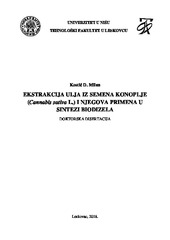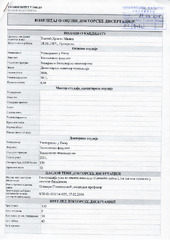Prikaz osnovnih podataka o disertaciji
Ekstrakcija ulja iz semena konoplje (Cannabis sativa L.) i njegova primena u sintezi biodizela
| dc.contributor.advisor | Stamenković, Olivera | |
| dc.contributor.other | Veljković, Vlada | |
| dc.contributor.other | Milojević, Svetomir | |
| dc.creator | Kostić, Milan D. | |
| dc.date.accessioned | 2018-12-24T10:40:11Z | |
| dc.date.available | 2018-12-24T10:40:11Z | |
| dc.date.available | 2020-07-03T16:14:13Z | |
| dc.date.issued | 2018-09-28 | |
| dc.identifier.uri | http://eteze.ni.ac.rs/application/showtheses?thesesId=6359 | |
| dc.identifier.uri | https://nardus.mpn.gov.rs/handle/123456789/10439 | |
| dc.identifier.uri | https://fedorani.ni.ac.rs/fedora/get/o:1522/bdef:Content/download | |
| dc.identifier.uri | http://vbs.rs/scripts/cobiss?command=DISPLAY&base=70052&RID=534015126 | |
| dc.description.abstract | The subject of this doctoral dissertation research was to obtain the oil from hemp seeds and to use it for biodiesel production. The main goals of the dissertation were optimization of operating conditions, kinetics modeling and thermodynamic analysis of maceration process, as well as optimization and modeling of hempseed oil methanolysis reaction kinetics. In order to determine the dependence of oil yield on process conditions process conditions and modeling the hempseed oil maceration, the response surface methodology (RSM) in combination with 33 full factorial design with replication, as well as artificial neural network combined with genetic algorithm (ANN-GA) were used. The variance analysis (ANOVA) revealed that extraction temperature had the greatest influence on the hempseed oil yield, followed by seed:solvent ratio and extraction time. Optimal extraction conditions determined by RSM (extraction temperature 70 oC, seed:solvent ratio 1:7.9 g/ml and 12.3 min extraction time) and ANN-GA methods (extraction temperature 70 oC, seed:solvent ratio 1:10 g/ml and 10 min extraction time) were very close. The predicted oil yield values determined by second-order polynomial equation and neural network model agreed very well with experimentally obtained values, so both models are acceptable for oil yield prediction in the investigated extraction conditions range. The two kinetic models were used for modeling the kinetics of hempseed oil maceration: simultaneous washing and diffusion (phenomenological model) and instantaneous washing followed by diffusion (simplified phenomenological model). In both cases, good agreement between the predicted and actual hempseed oil yields was obtained, indicated by low mean MRPD (±2.5% in the case of a phenomenological model and ±2.8% in the case of a simplified model). The thermodynamic analysis results of the hempseed oil extraction have shown that the oil extraction was spontaneous, endothermic and irreversible. For the biodiesel production, hempseed oil was obtained by seed pressing. As the free fatty acids (FFAs) content in the oil was higher than 2%, the synthesis of fatty acid methyl esters (FAMEs) was carried out by a two-stage process including acid-catalyzed esterification of FFAs in the oil followed by base-catalyzed methanolysis of esterified oil. The methanolysis reaction was carried out in the presence of quicklime as a catalyst, at different methanol:oil molar ratios and various amounts of catalyst. According to the ANOVA results, catalyst concentration, reaction time, interaction of the catalyst concentration and reaction time, as well as the square of reaction time had statistically significant influence on the FAMEs content of hempseed oil, while the effects of methanol:oil molar ratio, its interaction with the two other factors as well as squares of methanol:oil molar ratio and catalyst concentration, were statistically insignificant. The reliability of the model in predicting the FAMEs content was confirmed by appropriate statistical criteria and low MRPD value. The irreversible pseudo-first order kinetic model and model that included the changing mechanism of the reaction and the triacylglycerols mass transfer limitation were applied for modeling the methanolysis reaction kinetics of esterified hempseed oil. The catalyst concentration and the initial methanol concentration had no effect on the apparent rate constant of esterified oil methanolysis reaction, and its value, determined using both kinetic models, was 0.141 min-1. Both kinetic models are reliable in presenting a change in the triacylglycerol conversion degree, but the irreversible pseudo-first-order reaction model is more acceptable because it has a slightly lower MRPD value between the predicted and actual values of FAMEs content. | en |
| dc.format | application/pdf | |
| dc.language | sr | |
| dc.publisher | Универзитет у Нишу, Технолошки факултет, Лесковац | sr |
| dc.relation | info:eu-repo/grantAgreement/MESTD/Integrated and Interdisciplinary Research (IIR or III)/45001/RS// | |
| dc.rights | openAccess | en |
| dc.rights.uri | https://creativecommons.org/licenses/by-nc-nd/4.0/ | |
| dc.source | Универзитет у Нишу | sr |
| dc.subject | Seme konoplje | sr |
| dc.subject | Hemp seed | en |
| dc.subject | extraction | en |
| dc.subject | oil | en |
| dc.subject | maceration | en |
| dc.subject | biodisel | en |
| dc.subject | quicklime | en |
| dc.subject | methanolysis | en |
| dc.subject | optimization | en |
| dc.subject | kinetics | en |
| dc.subject | ekstrakcija | sr |
| dc.subject | ulje | sr |
| dc.subject | maceracija | sr |
| dc.subject | biodizel | sr |
| dc.subject | negašeni kreč | sr |
| dc.subject | metanoliza | sr |
| dc.subject | optimizacija | sr |
| dc.subject | kinetika | sr |
| dc.title | Ekstrakcija ulja iz semena konoplje (Cannabis sativa L.) i njegova primena u sintezi biodizela | sr |
| dc.type | doctoralThesis | en |
| dc.rights.license | BY-NC-ND | |
| dc.identifier.fulltext | http://nardus.mpn.gov.rs/bitstream/id/54745/Disertacija.pdf | |
| dc.identifier.fulltext | https://nardus.mpn.gov.rs/bitstream/id/54745/Disertacija.pdf | |
| dc.identifier.fulltext | http://nardus.mpn.gov.rs/bitstream/id/54746/Kostic_Milan.pdf | |
| dc.identifier.fulltext | https://nardus.mpn.gov.rs/bitstream/id/54746/Kostic_Milan.pdf | |
| dc.identifier.rcub | https://hdl.handle.net/21.15107/rcub_nardus_10439 |



